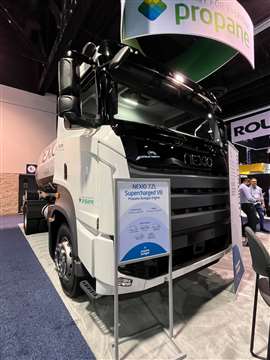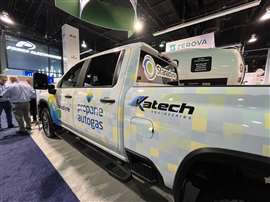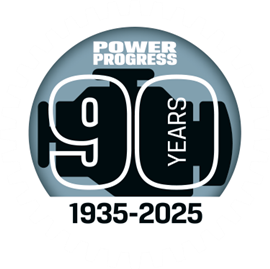PERC highlights propane tech and trends at ACT Expo
24 June 2025
Propane autogas is often touted as a cost-effective, reliable alternative to other commercial vehicle fuels. In the U.S., it’s particularly plentiful; the U.S. Energy Information Administration (EIA) reported that in 2024, the U.S. produced more than 787 million barrels of propane. There is so much, in fact, that the country exports more than it uses — over 651 million barrels in 2024, or 82 percent of production, according to EIA data. Furthermore, propane exports have consistently increased over the past 17 years, EIA said in a March report, with 2024 average daily exports setting a record.
ACT Expo 2025 saw some companies showcase propane-powered commercial vehicles. For example, in a departure from the school buses for which it is known, Blue Bird debuted a purpose-built propane-powered stripped chassis for Class 5-6 commercial vehicles.
PERC at ACT
Propane autogas technology was also featured in the Propane Education & Research Council (PERC) booth. One was a bi-fuel system made by Alliance AutoGas.
 The Nexio truck is powered by a propane-fueled 7.2L engine that delivers 330 hp. (Photo: Becky Schultz)
The Nexio truck is powered by a propane-fueled 7.2L engine that delivers 330 hp. (Photo: Becky Schultz)
“It will run off of propane autogas and then gasoline for extended range,” said Joel Stutheit, senior manager of autogas business development at PERC, adding that the system uses a fuel delivery system from Prins, which is a brand of Westport Fuel Systems.
Also in the PERC booth was a chassis from propane-powered truck maker Nexio that Stutheit said was in the development stages.
“This is a fully dedicated propane engine that Nexio has developed with the chassis,” he said. “It’s meant for more of the Class 7 and Class 8 truck and will offer an option for fleets that are looking for a truck to meet their need for air brakes and medium- and heavy-duty performance.”
The chassis in the PERC booth had a bobtail. However, Stutheit added that Nexio plans to sell the unit as a stripped cab and chassis for upfitters to customize.
Finally, PERC featured a Chevrolet Silverado truck with technology from Stanadyne, which used ACT Expo to debut its new propane direct-injection fuel system.
“They work with Katech,” Stutheit said of Stanadyne, which also partnered with PERC on the project. Katech specifically helped Stanadyne address issues of vapor lock, which is an obstacle common to direct injection of liquefied gases.
In announcing that the technology would be on display at ACT Expo, Srinu Gunturu, Stanadyne’s chief engineer, said, “This technology not only reduces emissions but also makes clean propulsion more accessible for medium- and heavy-duty vehicles where electrification remains a challenge.”
Despite the debut at the event, the approach is still being validated.
“They’re doing testing now,” Stutheit said. “In fact, they had to stop testing to bring the truck [to ACT Expo]. So, it’s going to leave here and then go back to testing.”
He added that both the Nexio and Stanadyne projects will seek U.S. Environmental Protection Agency (EPA) and California Air Resources Board (CARB) certification.
Propane + Electrification
While PERC promotes propane as a clean alternative fuel in its own right for internal combustion (IC) engines, it also sees the fuel as supporting another technology driving net-zero emissions: electrification via propane-powered electric vehicle (EV) charging.
“It’s a propane generator that will power the charging unit,” Stutheit said. “They can charge the vehicles from that.”
Stutheit added that powering EV chargers with propane is flexible and cost-effective.
“First, propane is the most cost-effective fuel compared to diesel and gasoline,” he said. “It offers stable pricing, without the significant fluctuations often seen with traditional fuels. This pricing stability makes propane-powered EV chargers a more attractive option, especially when compared to the high energy costs and slow infrastructure rollout associated with electric-only solutions.”
 This Chevrolet Silverado featured propane direct injection from Stanadyne and Katech. (Photo: Becky Schultz)
This Chevrolet Silverado featured propane direct injection from Stanadyne and Katech. (Photo: Becky Schultz)
Such a structure could be temporary or permanent, Stutheit said.
In a recent article on its website, PERC said propane-powered EV charging offered benefits in a variety of applications. At construction sites, for example, which often lack access to grid power, these chargers can meet their needs while being available in towable and scalable configurations.
Material handling, which has seen an influx of electrified equipment, can put a strain on grid-connected charging resources, PERC said. Microgrids powered by propane can alleviate this while avoiding emissions related to traditional diesel-powered generators.
And for fleets, from buses to last-mile delivery to logistics, many operators are challenged by the time and expense of installing charging infrastructure. According to PERC, propane-powered EV chargers are significantly more cost-effective and can be deployed more quickly than traditional charging systems, which often have lead times of a year or more.
Propane’s Future
In looking at where propane is headed, Stutheit said he doesn’t expect adoption decline.
“With today’s advancements in engine technology, we’re seeing the same kind of performance improvements with propane autogas that we once saw when gasoline engines transitioned from carbureted systems to fuel injection,” he said. “The technology is here, and so is the engine performance. Propane isn’t missing a beat when it comes to horsepower and torque.”
Given that many fleets are becoming interested in propane autogas via the promise of renewable propane, which is made from feedstocks similar to those used in renewable diesel and biodiesel, Stutheit addressed the fuel’s availability.
“With the increased production of renewable propane, fleets have another cost-effective alternative fuel source to help reach their sustainability goals,” he said.
According to the Alternative Fuels Data Center (AFDC) of the U.S. Dept. of Energy (DOE), renewable propane production is estimated to be about 4.5 million gal. (approx. 107,000 barrels) per year, although that number could be greater. The largest production facilities are located in California and Louisiana, AFDC said.
POWER SOURCING GUIDE
The trusted reference and buyer’s guide for 83 years
The original “desktop search engine,” guiding nearly 10,000 users in more than 90 countries it is the primary reference for specifications and details on all the components that go into engine systems.
Visit Now
STAY CONNECTED




Receive the information you need when you need it through our world-leading magazines, newsletters and daily briefings.
CONNECT WITH THE TEAM










